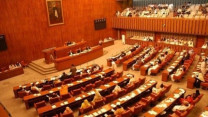NUST climbs four spots in QS Asia University Rankings
Retains position as solitary Pakistani varsity in top 100

NUST climbs four spots in QS Asia University Rankings
The National University of Singapore (NUS) was the top-ranked varsity in Asia. There’s only one new face in the top 10 this year - China’s Zhejiang University, which rises seven places to take the sixth position.
The Quacquarelli Symonds (QS) Asia University Rankings, a subgroup of the QS World University Rankings swelled by 68 higher education institutions this year to cover a total of 557 universities around Asia. While the rankings covered 17 different locations, only four regions are featured in the top 10.
As many as 29 universities are included from Pakistan in the rankings this year.
The rankings constructed using 10 different indicators, including academic and employer reputation, faculty-student ratio, citation per paper, paper per faculty, staff with PhD, and internationalization.
NUST retained its position as the top varsity from Pakistan and the solitary higher education institution from the country to make it into the top 100. It shared its position with the Shandong University of China. However, it fell behind Universiti Teknologi Petronas of Malaysia.
NUST has improved its rankings by 29 positions over the past three years, from 112 in the 2017 rankings, to 83 for 2020. The varsity is also among the top 400 global universities as per the QS World University Rankings 2020 announced earlier this year.
Amongst the other top five Pakistani universities included in the rankings were the Lahore University of Management Sciences (LUMS) at 110, the Quaid-i-Azam University (QAU) at 111, COMSATS Institute of Information Technology at 151, and the Pakistan Institute of Engineering and Applied Sciences (PIEAS) at 168.
LUMS fell 15 places from the 95 rank it held last year while QAU slipped two places from its 109 rank, COMSATS lost 16 places from its 135 rank, and PIEAS slipped 22 spots from its high rank of 146.
This year, Pakistan has a total of just seven varsities in top 200, down from eight last year.
Other varsities from Pakistan which have been included in the rankings include University of Engineering Technology (UET) Lahore, University of the Punjab Lahore, Aga Khan University (AKU), University of Karachi (UoK), University of Agriculture (UAF) Faisalabad, Bahauddin Zakariya University, Institute of Space Technology, International Islamic University Islamabad (IIUI), University of Lahore, Mehran University of Engineering and Technology, NED University of Engineering and Technology, University of Malakand, Bahria University Islamabad, Government College (GC) University, University of Sargodha, University of Veterinary and Animal Sciences Lahore, Dow University of Health Sciences, Islamia College University Peshawar, Ripah International University, University of Sindh, National University Computer and Emerging Sciences, Iqra University, University of Central Punjab and University of Management Technology.
In comparison to Pakistan, as many as 96 universities from India have been included in the rankings this year with the Indian Institute of Technology Bombay (IIT-Bombay) its highest-ranked higher education institution with a rank of 34. It is followed by IIT-Delhi at 43 and IIT-Madras at 50. Along with these three varsities in the top 50, India boasted a total of eight universities in the top 100.
Moreover, China dominated the rankings with 118 varsities, including four in the top 10. Tsinghua University was China’s top-ranked varsity, coming in at fourth spot. It was followed by Peking University at five, Zhejiang University at six and Fudan University at seven.
Published in The Express Tribune, November 28th, 2019.


















COMMENTS
Comments are moderated and generally will be posted if they are on-topic and not abusive.
For more information, please see our Comments FAQ